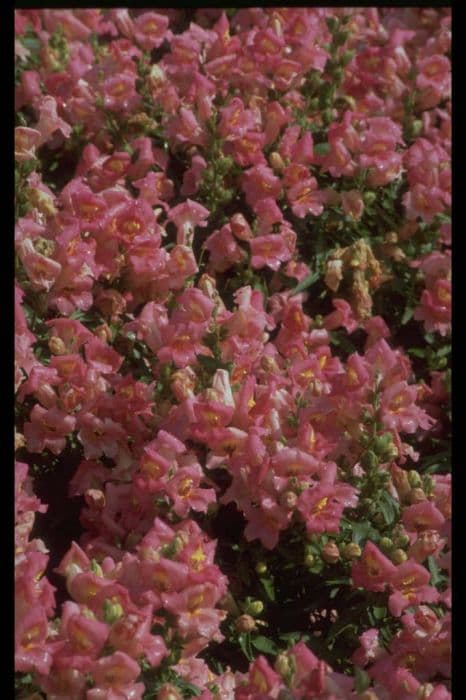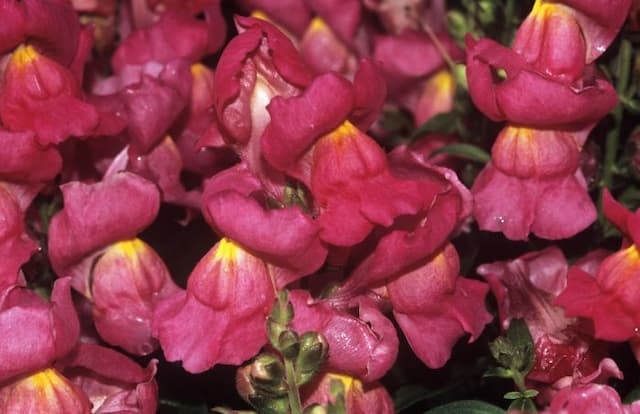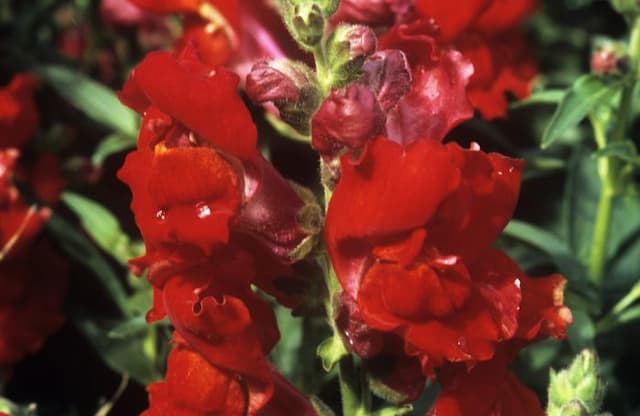Beardtongue Penstemon 'Blackbird' (Bird Series)

ABOUT
Penstemon 'Blackbird', part of the Bird Series, is an ornamental plant known for its striking features. It boasts a rich, dark foliage that serves as a wonderful backdrop for its flowers. The plant produces tubular blossoms that are a deep purple hue, evoking the color of ripe blackberries. Clusters of these flowers form at the tips of the stems and they possess a velvety texture that further enhances their luxurious appearance. The blooms are favored by hummingbirds and other pollinators, making Penstemon 'Blackbird' not only a visual treat but also beneficial for supporting local wildlife. Its leaves are narrow and pointed, adding a fine texture to the plant's overall structure. The plant's appearance is robust and can be quite captivating in a garden setting, providing a splendid display of dark foliage and deep purple flowers throughout its blooming season.
About this plant
 Names
NamesFamily
Plantaginaceae
Synonyms
Beardtongue, Blackbird Penstemon
Common names
Penstemon 'Blackbird'
 Toxicity
ToxicityTo humans
The Penstemon 'Blackbird', commonly known as Beardtongue, is not typically known to be toxic to humans. However, as with any plant, individual allergic reactions or sensitivities are possible. Ingesting plants that are not designated as food can sometimes cause gastrointestinal discomfort or other non-specific symptoms. If symptoms appear after ingestion, it is advised to consult a healthcare professional.
To pets
The Penstemon 'Blackbird', known commonly as Beardtongue, is not generally considered toxic to pets. While it is not specifically listed as poisonous, ingestion of non-food plants by pets can sometimes result in mild gastrointestinal upset such as vomiting or diarrhea. If your pet shows any adverse reactions after ingesting this plant, contact your veterinarian for advice.
 Characteristics
CharacteristicsLife cycle
Perennials
Foliage type
Semi-deciduous
Color of leaves
Green
Flower color
Purple
Height
2 feet (60 cm)
Spread
2 feet (60 cm)
Plant type
Herb
Hardiness zones
8
Native area
North America
Benefits
 General Benefits
General Benefits- Attracts pollinators: Penstemon 'Blackbird' is known for attracting bees and butterflies, which can benefit the pollination of surrounding plants.
- Drought tolerance: Once established, it is fairly drought-resistant, making it suitable for dry or xeriscape gardens.
- Low maintenance: This plant does not require much care beyond the basic needs of sunlight, well-drained soil, and occasional watering.
- Long blooming period: Penstemon 'Blackbird' has a lengthy flowering season, often from late spring to early fall, providing extended garden interest.
- Color and aesthetic appeal: Its deep purple flowers add a dramatic and bold color contrast to garden beds and borders.
- Erosion control: The root system can help stabilize soil and prevent erosion on slopes or in areas prone to soil loss.
- Wildlife habitat: It provides shelter and nectar sources for wildlife, enhancing biodiversity in the garden.
- Adaptability: Penstemon 'Blackbird' can adapt to a range of soil types, although it prefers well-drained conditions.
 Medical Properties
Medical PropertiesThis plant is not used for medical purposes.
 Air-purifying Qualities
Air-purifying QualitiesThis plant is not specifically known for air purifying qualities.
 Other Uses
Other Uses- Butterfly attraction: Penstemon 'Blackbird' flowers are known to attract butterflies, making them an excellent choice for butterfly gardens.
- Hummingbird garden: The tubular shape of its flowers is particularly appealing to hummingbirds.
- Pressed flower art: The vivid flowers of Penstemon 'Blackbird' can be pressed and used in floral art and crafts.
- Photography subject: With its bold, dark flowers, Penstemon 'Blackbird' is a striking subject for plant and garden photography.
- Edging plants: Their compact growth habit makes them suitable for use as edging along paths or garden beds.
- Dye production: Though not common, the flowers may potentially be used to produce natural dyes for fabrics or art projects.
- Educational tool: This plant can be used in educational settings to teach about pollination and the ecological importance of native flora.
- Rock gardens: Penstemon 'Blackbird' can be incorporated into rock gardens for added color and texture contrast.
- Seasonal interest: The plant provides seasonal interest in the garden, particularly in late spring to early summer when it typically blooms.
- Theme gardens: They can be used as part of a color-themed garden design, particularly in dark or 'black' flower themed areas.
Interesting Facts
 Feng Shui
Feng ShuiThe Penstemon is not used in Feng Shui practice.
 Zodiac Sign Compitability
Zodiac Sign CompitabilityThe Penstemon is not used in astrology practice.
 Plant Symbolism
Plant Symbolism- Resilience: Penstemons are known for their hardiness and ability to thrive in challenging conditions, symbolizing the ability to endure and overcome adversity.
- Attractiveness: The 'Blackbird' variety, with its striking dark flowers, can symbolize allure and the beauty of the unconventional.
- Boldness: The vividness of the Penstemon 'Blackbird' can be seen as a symbol of courage and standing out from the crowd.
- Versatility: As Penstemons can grow in various environments, they may represent adaptability and flexibility.
 Water
WaterBlackbird Penstemon should be watered deeply to encourage root growth, but the soil should be allowed to dry out between watering sessions to prevent root rot. During the spring and summer growing season, water approximately once a week with about one gallon per plant, adjusting for rainfall and temperature. In the fall and winter, reduce watering frequency to every two to three weeks, considering weather conditions. Overwatering can be detrimental, so it's essential to check the soil moisture before watering.
 Light
LightBlackbird Penstemon thrives in full sun to partial shade. The ideal spot for this plant is where it can receive at least six hours of direct sunlight each day. Morning sun with some afternoon shade is optimal in hot climates to prevent scorching, whereas in cooler climates, full sun all day encourages better flowering.
 Temperature
TemperatureBlackbird Penstemon can withstand a range of temperatures, but it performs best in conditions between 60°F and 75°F. It is hardy and can survive minimum temperatures down to around 20°F, but prolonged exposure to temperatures below freezing can be harmful. During hot spells, protection from the intense afternoon sun can help maintain ideal growing temperatures.
 Pruning
PruningPrune Blackbird Penstemon to remove spent flowers and encourage a second bloom, maintain its shape, and prevent it from becoming too woody. Deadheading, or cutting back the flower spikes after blooming, can be done throughout the flowering season. In late winter or early spring, cut back the entire plant by one-third to one-half to stimulate new growth and maintain a tidy appearance.
 Cleaning
CleaningAs needed
 Soil
SoilBeardtongue ‘Blackbird’ prefers well-draining soil with a slightly acidic to neutral pH of 6.0 to 7.0. A mixture of loam, sand, and compost or aged manure creates an ideal growing medium for this cultivar, ensuring good aeration and fertility.
 Repotting
RepottingBeardtongue ‘Blackbird’ typically does not require frequent repotting and should be repotted only when it outgrows its current container, about every 2 to 3 years.
 Humidity & Misting
Humidity & MistingBeardtongue ‘Blackbird’ is tolerant of a wide range of humidity levels but thrives best in moderate humidity conditions, without requiring specific humidity adjustments when grown outdoors.
 Suitable locations
Suitable locationsIndoor
Place in bright, indirect light and keep soil slightly moist for indoor beardtongue.
Outdoor
Full sun to part shade and well-draining soil are ideal for outdoor beardtongue.
Hardiness zone
5-9 USDA
 Life cycle
Life cycleThe life of Penstemon digitalis, commonly known as Beardtongue, begins with seed germination, which requires well-draining soil and typically occurs in spring when soil temperatures warm. Seedlings emerge and establish a rosette of foliage; during this juvenile phase the plant focuses on root and foliage growth. As it matures into its second year, the plant enters the vegetative stage, developing stems and more leaves, preparing for reproduction. Flowering occurs in late spring to early summer, characterized by tall spikes of tubular flowers that attract pollinators like bees and hummingbirds. After pollination, the plant produces fruit in the form of capsules enclosing small seeds. The plant may die back in winter but as a perennial, it resprouts from the root system to complete the cycle again the next season.
 Propogation
PropogationPropogation time
Spring to early summer
Propogation: The Penstemon 'Blackbird', commonly known as Beardtongue, is typically propagated by seed or by division. The most popular method amongst these is propagation by division, which should be performed in the springtime before new growth begins. To propagate Beardtongue by division, carefully dig up an established plant, ensuring a large root ball is intact. Gently separate the plant into smaller sections, each with a portion of the roots and several shoots. Replant the divisions immediately, spacing them about a foot (30 cm) apart, and water them thoroughly. This method is favored because it maintains the characteristics of the parent plant and results in quicker establishment in the garden compared to growing from seed.









